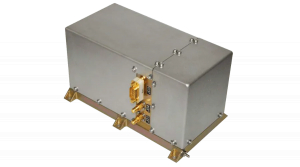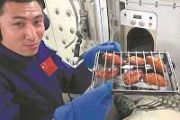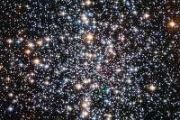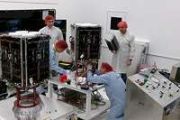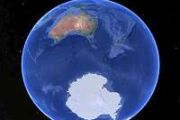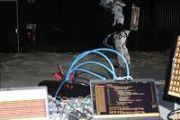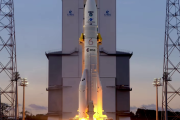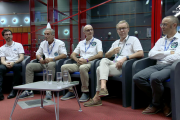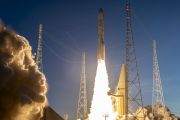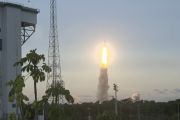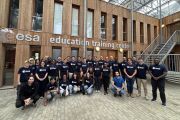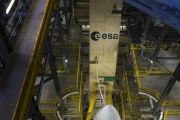
Copernical Team
Spectratime Rubidium Atomic Frequency Standard (RAFS)
Spectratime RAFS is designed with the latest technologies, providing advanced features, such as long lifetime, high reliability, lightweight and ultra low phase noise, for next-generation space applications.
Applications:
- GNSS/GPS navigational systems
- SAR systems
- FGU systems
- MRO systems
Key Features:
- Output 10 MHz and 10 MHz auxiliary
- Accuracy < 2E-10 after launch & commissioning < 1E-10 under vacuum at delivery
- Temp -5 to 10C
- Aging < 1E-10/yr
- Size (WxHxL) 217x124x117mm | 8.54x4.88x4.6"
- Weight 3.4 Kg | 7.49 lbs
- Lifetime/MTBF > 15 yrs / < 2000 fit span>
- Power (operating) < 35W
- Voltage 28V
- Warmup <60W
Russian Soyuz rocket launches 34 new UK satellites

A Russian Soyuz rocket has blasted into space carrying 34 new satellites from British operator Oneweb, which aims to provide broadband internet everywhere in the world.
The rocket, operated by Europe's Arianespace, took off at 1807 GMT Tuesday from the Baikonur cosmodrome in Kazakhstan, broadcast live by the Russian Roscosmos space agency.
"The launch went to plan," Roscosmos chief Dmitry Rogozin said on Telegram.
It was the sixth launch of OneWeb satellites this year, the last one having been on August 22.
OneWeb is working to complete the construction of a constellation of low-earth orbit satellites providing enhanced broadband and other services to countries worldwide.
The company is competing against billionaires Elon Musk and Jeff Bezos in the race to provide fast internet for the world's remote areas via satellites.
The UK company plans for its global commercial internet service to be operational by next year, supported by some 650 satellites.
Arianespace, which has worked with Russia for close to two decades, is under contract to make 16 Soyuz launches between December 2020 and the end of 2022.
Image: Energy Department mission launched from Wallops
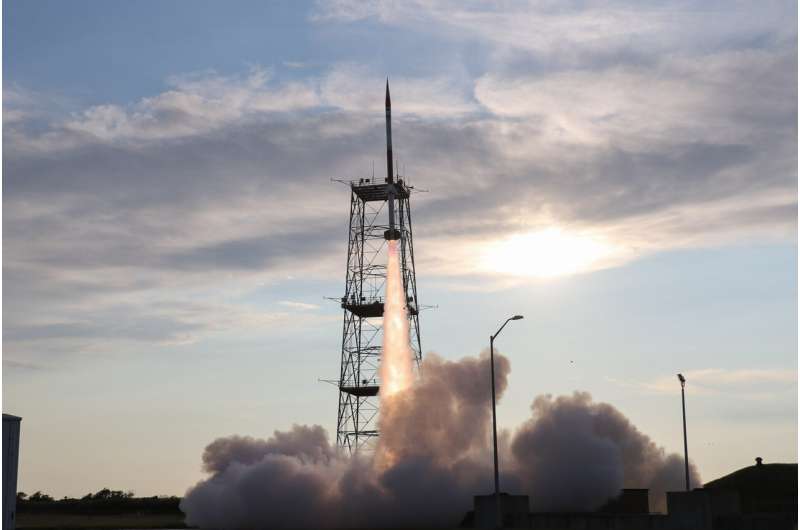
A two-stage suborbital sounding rocket launched at 6:07 p.m. EDT for the Department of Energy's National Nuclear Security Administration from NASA's launch range at Wallops Flight Facility on the Eastern Shore of Virginia.
The Terrier-Improved Malemute rocket flew the payload to an altitude of 99 miles. The payload descended by parachute and landed in the Atlantic Ocean, 59 miles from Wallops Island. The payload was recovered and preliminary indications are that good data was received.
The flight is part of the HOTShot program, short for High Operational Tempo, which collects scientific data that benefits aerospace research and informs future weapon designs for the U.S. nuclear enterprise. Its non-nuclear scientific experiments evaluate prototypes and help develop high-fidelity computer models and mechanical flight simulators.
The next rocket launch from Wallops is targeted for no earlier than October 2021.
Explore further
Virtual ESA Open Day registration now open

Registration for this year's virtual ESA Open Day is now open. This tenth annual ESA Open Day will take place on Sunday 3 October.
SpaceX launches Starlink satellites into orbit from West Coast
 Elon Musk's SpaceX successfully launched a stack of Starlink satellites into space Monday night, the first such launch since May.
The Falcon 9 rocket lifted off through a cloud of fog on schedule at 8:55 p.m. PDT from Space Launch Complex 4E at the Vandenberg Space Force Base in California, carrying 51 Starlink satellites into space, which were deployed about 30 minutes later.
SpaceX
Elon Musk's SpaceX successfully launched a stack of Starlink satellites into space Monday night, the first such launch since May.
The Falcon 9 rocket lifted off through a cloud of fog on schedule at 8:55 p.m. PDT from Space Launch Complex 4E at the Vandenberg Space Force Base in California, carrying 51 Starlink satellites into space, which were deployed about 30 minutes later.
SpaceX SPY-7 Hybrid Defense program with Japan completes additional capability tests
 On August 26, the Missile Defense Agency (MDA) and U.S. Navy Aegis Technical Representative (TECHREP) witnessed a successful Mid-Release 2 Demonstration of the software release for the Japanese J7.B Aegis Weapon System equipped with SPY-7 radar, in Moorestown, New Jersey. Japan will field J7.B onboard an afloat Aegis System-Equipped Vessel (ASEV) to provide ballistic missile defense (BMD).
On August 26, the Missile Defense Agency (MDA) and U.S. Navy Aegis Technical Representative (TECHREP) witnessed a successful Mid-Release 2 Demonstration of the software release for the Japanese J7.B Aegis Weapon System equipped with SPY-7 radar, in Moorestown, New Jersey. Japan will field J7.B onboard an afloat Aegis System-Equipped Vessel (ASEV) to provide ballistic missile defense (BMD). AFRL promotes 'one lab, two services' at Space Symposium
 Air Force Research Laboratory Commander Maj. Gen. Heather Pringle and other AFRL subject matter experts gathered to connect with the space community at the Space Foundation's 36th National Space Symposium in Colorado Springs August 23-27.
Space Foundation Chief Executive Officer, retired U.S. Navy Rear Admiral Thomas E. Zelibor opened the annual symposium, which was last hosted in April 20
Air Force Research Laboratory Commander Maj. Gen. Heather Pringle and other AFRL subject matter experts gathered to connect with the space community at the Space Foundation's 36th National Space Symposium in Colorado Springs August 23-27.
Space Foundation Chief Executive Officer, retired U.S. Navy Rear Admiral Thomas E. Zelibor opened the annual symposium, which was last hosted in April 20 New Navy task force to work on bringing unmanned systems into operations
 The U.S. Navy has set up its first-ever task force that'll use a vast ocean area in the Middle East as the setting for learning how to incorporate unmanned systems and artificial intelligence into maritime operations.
Task Force 59 will specifically be focused on the U.S. 5th Fleet area of operations, the Navy said on Thursday.
The fleet was selected for its strategic importance,
The U.S. Navy has set up its first-ever task force that'll use a vast ocean area in the Middle East as the setting for learning how to incorporate unmanned systems and artificial intelligence into maritime operations.
Task Force 59 will specifically be focused on the U.S. 5th Fleet area of operations, the Navy said on Thursday.
The fleet was selected for its strategic importance, US Navy sets up Gulf drone task force amid Iran tensions
 The US Navy's Fifth Fleet said Thursday it launched a new task force in the Gulf incorporating drones and artificial intelligence following maritime attacks blamed on Iran.
A statement by the US Naval Forces Central Command, or NAVCENT, said the task force would rely on regional and coalition partnerships.
"The bottom line on why we're doing this is so that we can develop and integrate u
The US Navy's Fifth Fleet said Thursday it launched a new task force in the Gulf incorporating drones and artificial intelligence following maritime attacks blamed on Iran.
A statement by the US Naval Forces Central Command, or NAVCENT, said the task force would rely on regional and coalition partnerships.
"The bottom line on why we're doing this is so that we can develop and integrate u SpiderOak wins second Air Force contract for secure space communications
 The U.S. Air Force has approved an approximately $750,000 Small Business Innovation Research grant to SpiderOak to test its new OrbitSecure secure communications protocol on military satellites and ground stations. The outcome will enable government agencies to leverage commercial space assets for federal missions in emerging hybrid space architectures that mix commercial and government satellit
The U.S. Air Force has approved an approximately $750,000 Small Business Innovation Research grant to SpiderOak to test its new OrbitSecure secure communications protocol on military satellites and ground stations. The outcome will enable government agencies to leverage commercial space assets for federal missions in emerging hybrid space architectures that mix commercial and government satellit 
